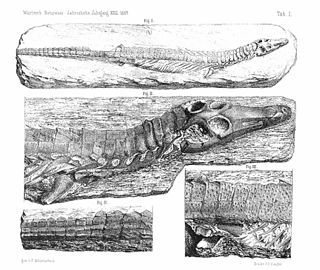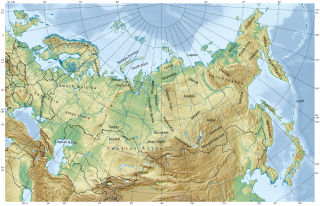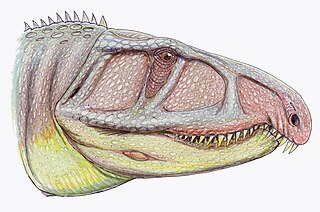The Permian is a geologic period and system which spans 47 million years from the end of the Carboniferous period 298.9 million years ago (Mya), to the beginning of the Triassic period 251.902 Mya. It is the last period of the Paleozoic era; the following Triassic period belongs to the Mesozoic era. The concept of the Permian was introduced in 1841 by geologist Sir Roderick Murchison, who named it after the region of Perm in Russia.

Garjainia is an extinct genus of erythrosuchid archosauriform reptile from the Olenekian of Russia and South Africa. It was approximately 1.50–2 m long. It contained two species, Garjainia prima from the Yarengian/Yarkenskian Supergorizont of Russia, and Garjainia madiba from the Burgersdorp Formation of South Africa. "Vjuskovia triplicostata", a name assigned to some erythrosuchid fossils from Russia, has been synonymized with Garjainia prima.
Bukobaja is an extinct genus of mastodonsaurid temnospondyl from the middle Triassic of Russia. It contains a single species, Bukobaja enigmatica. Bukobaja mainly occurs in the Bukobay Svita as part of the Ladinian?-age "Mastodonsaurus fauna", a section of Russian Triassic biostratigraphy characterized by "Mastodonsaurus" torvus. It was also present in the underlying Donguz Svita. Bukobaja appears to be a valid genus similar to, yet distinct from, Mastodonsaurus. Despite appearing to possess several unique features, Bukobaja is still known from very few remains. This has led to difficulties in determining its relations more precisely than "Mastodonsauridae incertae sedis". It has also been compared to trematosaurids.

Dyoplax is an extinct genus of pseudosuchian archosaur, possibly an erpetosuchid. Fossils have been found from the type locality within the upper Schilfsandstein Formation in Stuttgart, Germany. The holotype specimen was a natural cast of a nearly complete skeleton that lacked only parts of the tail and limb bones.
Jushatyria is an extinct genus of archosaur. Fossils have been found in the Koltaevo III Locality, district of Kumertau near the Ural Mountains in European Russia from the Bukobay Gorizont. The locality dates back to the Ladinian stage of the Middle Triassic. Additional material has been described from a locality on the banks of the Berdyanka River that was previously assigned to a rauisuchid-like archosaur. However, this material differed from the original specimens because it lacked slit-like antorbital openings accompanying the antorbital fossa. Nesbitt (2009) and Gower and Sennikov (2000) suggested that all material currently referred to Jushatyria most likely does not represent a single taxon. Thus, Jushatyria is known only from its holotype PIN 2867/5, an incomplete left maxilla. As the maxilla is damaged, many "rauisuchian" characters could not be verified. Jushatyria was reassigned as an indeterminate archosaur on the basis of the presence of an antorbital fossa on the lateral surface of the maxilla.
Vjushkovisaurus is an extinct genus of Middle Triassic archosauriform. It is known from the Anisian-aged Donguz Gorizont in Sol-Iletsk, Orenburg Oblast, Russia. The genus was named in 1982, with the type species being V. berdjanensis. Material has been collected in the Berdyanka II locality from a fossil assemblage called the Eryosuchus Fauna along the Berdyanka River, specifically in a sand-carbonate concretion in the upper part of the main river channel. Vjushkovisaurus is known only from the holotype PIN 2865/62, a partial postcranial skeleton which consists of 12 presacral vertebrae, left humerus, ribs, a fragment of the coracoid and a fragment of the fibula.

The geology of Russia, the world's largest country, which extends over much of northern Eurasia, consists of several stable cratons and sedimentary platforms bounded by orogenic (mountain) belts.
Olson's Extinction was a mass extinction that occurred 273 million years ago in the early Guadalupian of the Permian period and which predated the Permian–Triassic extinction event. It is named after Everett C. Olson. There was a hiatus and a sudden change in between the early Permian and middle/late Permian faunas. Since then this event has been realized across many groups, including plants, marine invertebrates, and tetrapods.
Vritramimosaurus is an extinct genus of large early archosauromorph. Although originally placed in the family Prolacertidae, recent studies on archosauromorph relationships doubt the validity of the family, at least in its broadest sense. Fossils have been found from Early Triassic deposits of the Rassypnaya locality in Orenburg Oblast, Russia. Rassypnaya is located on the Obshchy Syrt, a plateau in the European part of Russia that extends southwest of the Urals toward the Volga River. Vritramimosaurus is similar to the later genus Malutinisuchus, also from Rassypnaya but present in Middle Triassic deposits.
Malutinisuchus is an extinct genus of Archosauromorph. The genus was named in 1986 with the description of the type species M. gratus. Malutinisuchus is known from Ladinian-age Middle Triassic deposits in the Bukobay and Rassypnaya localities in Orenburg Oblast, Russia. In Russia, deposits of this age are referred to the Bukobay Gorizont.
Vonhuenia is an extinct genus of basal archosauriform from the Early Triassic of Russia. Fossils have been found in the Vokhminskaya Formation, along the Vetluga River that are Induan in age, making Vonhuenia one of the earliest archosauriforms.
Blomosuchus is an extinct genus of archosauriform from the Early Triassic of Russia. The type species was named in 1992 as Blomia georgii. However, the name Blomia was preoccupied by a genus of mites in the family Glycyphagidae (Blomia), so the genus was renamed Blomosuchus in 1997. Fossils of Blomosuchus have been found along the Vetluga River besides fossils of another problematic archosauriform, Vonhuenia.
Exilisuchus is an extinct genus of archosauromorph reptile from the Early Triassic of Russia. The type species E. tubercularis was named in 1979. Fossils are known from two Russian assemblages, the Benthosuchus - Thoosuchus assemblage and the Angusaurus assemblage. Both are Olenekian in age. Although initially believed to be a proterosuchid archosauriform, a 2016 analysis found that it also shared features with tanystropheids, and thus is currently classified as Archosauromorpha incertae sedis. Due to the small amount of preserved material, this genus is sometimes considered a nomen dubium.
Koinia is an extinct genus of temnospondyl amphibian from the Late Permian of Russia. It is an archegosauroid in the subfamily Melosaurinae. Koinia was named in 1993 with the description of the type species K. silantjevi, based on fossils that were found in the Ocher Assemblage Zone, near the Vym River in the Komi Republic.

Uralosaurus is an extinct genus of erythrosuchid archosauriform known from the Middle Triassic Donguz Formation of southeastern European Russia. It contains a single species, Uralosaurus magnus. It was named by Vitalii Georgievich Ochev in 1980 as a species of Erythrosuchus otherwise known from the Triassic of Africa and reassigned to its own genus by Andrey G. Sennikov in 1995.
Boreopricea is an extinct genus of archosauromorph reptile from the Early Triassic of arctic Russia. It is known from a fairly complete skeleton discovered in a borehole on Kolguyev Island, though damage to the specimen and loss of certain bones has complicated study of the genus. Boreopricea shared many similarities with various other archosauromorphs, making its classification controversial. Various studies have considered it a close relative of Prolacerta, tanystropheids, both, or neither. Boreopricea is unique among early archosauromorphs due to possessing contact between the jugal and squamosal bones at the rear half of the skull.

The Bukobay Svita is a Middle Triassic geological unit in Russia. It is composed primarily of red or grey lacustrine sediments, reconstructing a humid and marshy depositional environment. Bukobay is the youngest section of a Triassic terrestrial succession exposed south of the Ural Mountains. It is equivalent to a biostratigraphic unit, the Bukobay Gorizont, which is also called the "Bukobay Horizon" or "Mastodonsaurus" fauna).
The Yarenskian Gorizont is a major biostratigraphic unit in Russia corresponding to Upper Olenekian-age terrestrial sediments. It lies above the Ustmylian Gorizont of the Vetlugian Supergorizont, and is located below a short unconformity overlain by the Donguz Gorizont. Some paleontologists elevate the Yarenskian to a supergorizont and subdivide it into two smaller units: the older Fedorovskian Gorizont and the younger Gamskian Gorizont. Others prefer to consider the Fedorovskian and Gamskian to be subgorizonts or members of the Yarenskian. Vertebrate index fossils of the Fedorovskian include the lungfish Gnathorhiza, the trematosaurid Inflectosaurus, and the procolophonid Burtensia. In the Gamskian, these index fossils are replaced by Ceratodus, Trematosaurus, and Kapes, respectively. The Yarenskian as a whole is characterized by the capitosaur amphibian Parotosuchus, and has also been known as the Parotosuchus fauna. A few geographical influence on the faunas can be observed; erythrosuchids and rhytidosteids are more common in southern exposures while procolophonids and putative "rauisuchids" are more common in the north.
The Ustmylian Gorizont is a Lower Triassic biostratigraphic unit in Western Russia. The Ustmylian Gorizont is the youngest subunit of the Vetlugian Supergorizont, lying above the Sludkian Gorizont and below the Yarenskian Gorizont. It corresponds to the later part of the early Olenekian stage. Along with the Sludkian Gorizont, the Ustmylian Gorizont is encompassed by the "Wetlugasaurus fauna", named after a capitosaur amphibian index fossil. While the Sludkian is characterized by Wetlugasaurus angustifrons, the Ustmylian is characterized by Wetlugasaurus malachovi.






